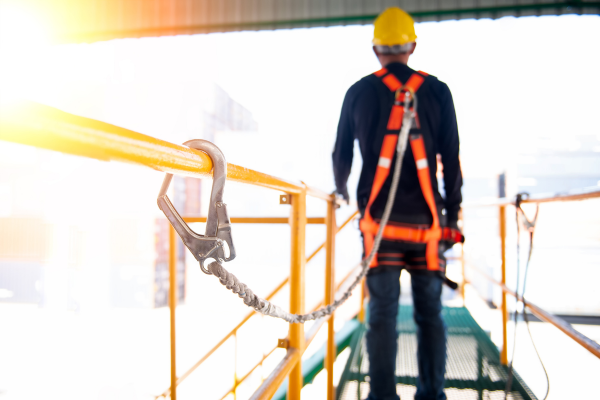We are Doing Good, But We Can Do Better – The Importance of Safety in Construction
Houston Principal Patrick Garner recently wrote the following article for the November edition of Construction News magazine. Here, Patrick discusses the importance of safety in construction.

“There are three kinds of lies: Lies, Damned Lies, and Statistics” — This famous quote has been attributed to Mark Twain, but no one really knows where it originated.
Regarding construction safety information, the majority of information comes from the Bureau of Labor Statistics (BLS) and according to the BLS, there were 5,190 workplace fatalities in 2021. More than 1,000 of those fatalities were in the construction sector. Furthermore, more than one hundred sixty-nine thousand two hundred (169,200) non-fatal construction related injuries occurred in 2021. However, that is not the worst part.
What is worse — the statistics only represent those incidents reported and recorded. Approximately 65% of incidents are never reported, recorded, or documented as a construction injury. That is a lot of lost time, lost productivity, and lost opportunity.
The good news is… We are getting better. The numbers are actually trending downward.
Construction sites are dynamic environments where skilled workers labor to bring architectural visions to life. However, amidst the hustle and bustle, it’s essential to remember that safety should always be the top priority. The risks inherent in construction work can lead to severe injuries or even fatalities if proper precautions aren’t taken.
Protect Lives and Livelihoods
The most compelling reason to prioritize safety on a construction site is to protect the lives of workers. Construction is inherently dangerous, with hazards ranging from falls, machinery accidents, electrical shocks, to exposure to hazardous substances. As shown above, nearly 20% of all worker fatalities in the United States occur in the construction industry. This alarming statistic underscores the vital need for stringent safety protocols.
Beyond preserving lives, safety measures also safeguard the livelihoods of workers. A construction accident can result in debilitating injuries that lead to extended periods of recovery or even permanent disability. This can have devastating financial consequences for both the affected worker and their family. Additionally, accidents can result in costly lawsuits and fines for construction companies, potentially jeopardizing the viability of the project and the business itself.
Enhance Productivity and Efficiency
A safe work environment is also a more efficient one. When workers feel secure, they can focus on their tasks without the distraction of worrying about potential hazards. This fosters a culture of productivity and professionalism. Conversely, when safety is neglected, workers may be reluctant to fully engage with their tasks, leading to reduced output and lower-quality work.
Moreover, a safe work-site minimizes the likelihood of accidents and disruptions. A single accident can halt operations for hours or even days as investigations are conducted and damaged equipment is repaired or replaced. This downtime can lead to significant delays in project completion, incurring additional costs and potentially tarnishing the reputation of the construction company.
Comply with Legal and Regulatory Standards
Adhering to safety protocols is not just a matter of ethics; it’s a legal requirement. Regulatory bodies like OSHA in the United States and similar organizations worldwide impose stringent safety standards for construction sites. Failure to comply with these regulations can result in severe penalties, including fines and even criminal charges in cases of gross negligence.
In addition to governmental regulations, many clients and project owners now require contractors to meet specific safety criteria as part of their contracts. Non-compliance can lead to the termination of contracts, loss of business, and damage to a company’s reputation.
Foster a Culture of Responsibility
Prioritizing safety sends a powerful message to workers that their well-being is valued. This fosters a culture of responsibility and accountability. When employees see that their employer is committed to their safety, they are more likely to take personal responsibility for their actions and the well-being of their colleagues.
Furthermore, when safety is a core value of a construction company, it attracts and retains high-caliber workers. Skilled laborers are more likely to seek out employers who prioritize their safety and well-being, leading to a more skilled and capable workforce.
Implement Safety Measures
Ensuring safety on a construction site involves a multifaceted approach. Here are some key measures that can be implemented:
- Regular Training: Provide comprehensive training to all workers on safety protocols, hazard recognition, and proper use of equipment.
- Personal Protective Equipment (PPE): Ensure that all workers have access to and are wearing appropriate PPE, including helmets, safety glasses, gloves, and harnesses.
- Fall Protection: Install guardrails, safety nets, and harness systems to protect workers from falls, which are a leading cause of construction accidents.
- Machinery Safety: Regularly inspect and maintain all construction equipment, and provide thorough training on their safe operation.
- Emergency Response Plans: Establish clear protocols for responding to accidents or emergencies, and ensure that all workers are familiar with these procedures.
- Site Inspections: Conduct regular inspections to identify and address potential hazards before they lead to accidents.
- Communication: Encourage open communication between workers and supervisors regarding safety concerns or suggestions for improvement.
Safety on a construction site is not a luxury but an absolute necessity. It protects lives, preserves livelihoods, enhances productivity, ensures legal compliance, and fosters a culture of responsibility. By implementing rigorous safety measures, construction companies can create a work environment that not only delivers high-quality projects but also prioritizes the well-being of your most valuable asset: your workers.

Houston Principal Patrick Garner is a trial lawyer with more than 26-years of experience handling litigation, administrative proceedings, arbitrations, and appeals in both federal and state court. His experience is handling matters involving commercial and industrial construction, construction safety, wrongful death, personal injury defense, premises liability, employment litigation and administrative proceedings, and commercial litigation. Patrick has handled matters all over the United States.
Patrick is AV rated, a member of State Bar Litigation, Construction, and Labor & Employment Law Sections, as well as the Houston Bar Association Litigation, Construction, and Labor & Employment Law Sections. Patrick is a member of various professional organizations including: the College of the State Bar of Texas, Texas Association of Defense Counsel, Associated Builders & Contractors, Associated General Contractors of America, and the Society of Construction Lawyers – North America. He is admitted to practice in all Texas state and federal courts, as well as the Fifth Circuit and United States Supreme Court.
About Cokinos | Young
Cokinos | Young has led Texas construction and real estate law for over three decades. And today, our 100+ dedicated professionals operate coast to coast and proudly handle all aspects of construction law for owner/developers, project managers, general contractors, design professionals, subcontractors, sureties, and lenders. We provide both dispute resolution and transactional services to clients through all phases of commercial, industrial, pipeline, offshore, civil, and residential construction. Our reputation was built on relentless commitment to client service and the industries we serve, and that remains our primary driver. Dedicated. Resilient. Expertise. That’sCokinos | Young. Learn more at cokinoslaw.com.